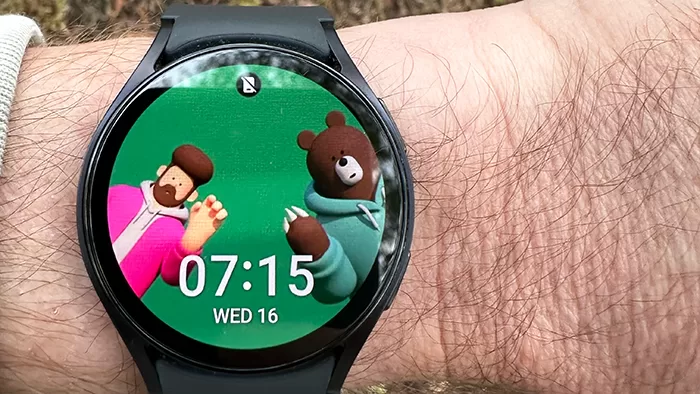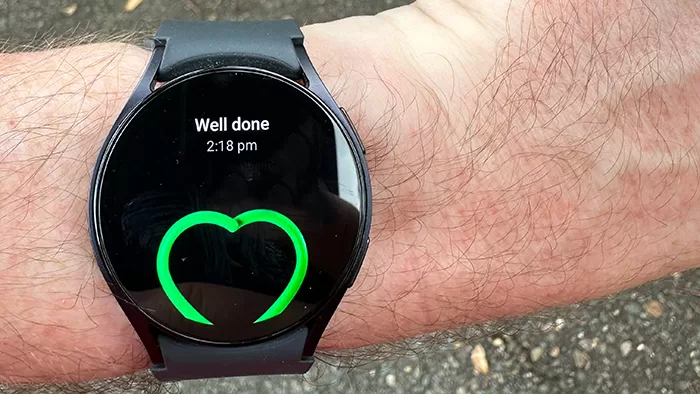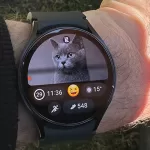
| Pros | Cons |
|---|---|
| Lightweight and comfortable | Not much has really changed since prior generation Galaxy Watches |
| Works nicely with Samsung smartphones | Battery life hasn’t improved either |
| Nice array of fitness, sleep and health features | Rotating dial only on the Classic model |
Score: 4/5
Not that long ago, I read an article that was incredulous that one of Samsung’s early smartwatches had a camera in it.
This reminded me of two things.
Firstly, I’ve been doing this tech reviewing gig for a long, long time, because I can rather clearly remember that precise smartwatch. I even made a (quick) video about it back in the day:
Ignore the URL in that video; I’ve got no control over it. Instead read my reviews well… here!
Secondly, what that really pointed out to me was the fact that this was a decade ago. Samsung has a long history in smart and capable wearables, and while the idea of a camera on a smartwatch still feels creepy to me (because it is), the core ideas in that watch have carried through the generations, even as Samsung’s switched from its own Tizen OS over to Google’s WearOS. For a long time, Samsung’s smartwatches have been the ones to beat.
There’s a problem here, however, and it’s much the same one that I noted in my review of the Samsung Galaxy Z Fold 5. If you’re the only competitor in a space, it’s often the case that you’ll rest on your laurels. For the Fold 5 it really is lacking credible local competition, so that makes an amount of sense.
Also read:
Samsung Galaxy Z Fold 5 Review
For the Galaxy Watch 6… well, it’s still a very good and mostly capable smartwatch, but it’s definitely one that’s rested on its laurels as its competition has changed the smart wearables game.
If you’re heavily in the Samsung ecosystem it still makes a lot of sense – but it’s not your only choice, and it certainly doesn’t feel like all that much has changed here.
Design

The Samsung Galaxy Watch 6 comes in two different sizes… or sort of four, really.
Strictly speaking, there’s a choice of a 40mm watchface or larger 44mm watchface for the Galaxy Watch 6. But then there’s the Galaxy Watch 6 Classic, which is the variant that has the actual physical rotating bezel around its 43mm or 47mm faces. I’m not so sure how a brand new watch is a “classic”, but in this case it’s Samsung referring to its “classic” watch design, when the rotating bezel was king.
As far as I’m concerned, it very much still is, because that rotating bezel both works well and gives Samsung a real unique point of difference that makes a lot of sense for a circular smartwatch.
I’ve only had the lightest amount of time with the Galaxy Watch 6 Classic, however, with my actual review conducted on a graphite 40mm Galaxy Watch 6. Your choice of watch colour will vary a little depending on the model you want. The 40mm model ships in Graphite or Gold finishes, the 44mm in Silver or Graphite and the Galaxy Watch 6 Classic in Silver or Black in either size.
So suddenly those four choices are up to eight choices across four sizes if you’re fussed about watch colours and appearance. Given there’s a level of watch wearing that’s not strictly needed these days – I mean, your smartphone can do many things including tell time, for example – you probably should be fussy about the colour of your watch matching your taste. It’s a bit inevitable, but it does feel just a little bit annoying that you can’t get all colours across all watch types.
Samsung’s done some tweaking to the bezel size on the Galaxy Watch 6 which on paper puts it ahead of the Galaxy Watch 5. In reality though, unless you put them side to side, you’re not likely to notice that, and it really doesn’t make a huge difference to how the watch actually operates once it’s on your wrist. The default graphite strap is easy to put into place and mostly comfortable, though I did notice a little pinching after one particularly heavy run workout session. I guess I can’t blame the Galaxy Watch 6 just because I got a bit hot and sweaty.
Also, sorry, Samsung. I sweated all over your review watch, but I will clean it up before it goes back to you.

Physically the Galaxy Watch 6 has two control buttons that can be customised, as well as the usual WatchOS array of swipes in different directions to access a variety of watch functions.
You can also spin your finger around the bezel to try to imitate the rotating bezel of the Classic watch, a move Samsung seems to think is a substitute for that spinning bezel. I tend to disagree, but then I can accept that not everyone will be a fan of a physical bezel, and you can ignore that function entirely and still use every part of the Galaxy Watch 6 anyway.
Performance

Setting up the Galaxy Watch 6 will depend on the smartphone you want to pair it with.
If you’re rocking an iPhone… forget it.
Just as the Apple Watch doesn’t work with anything Android, the Galaxy Watch 6 and Galaxy Watch 6 are Android-only devices. Rather predictably pairing is easiest if you’re also using a Samsung smartphone, because you’ll get a friendly pop-up when you first power up the Galaxy Watch 6, and many of the needed apps and permissions are already in place. Pair to other Android phones and it works, but it’s a more fiddly process.
The Galaxy Watch 6 runs WearOS 4 with Samsung’s own One UI 5 launcher on Samsung’s new Exynos W930 processor, which Samsung reckons is both faster and more battery efficient than the older Galaxy Watches were.
More on the battery front later, but on the pure processing front, it’s certainly slick, though I had some difficulty really picking it as “faster” for most of the regular Watch apps I was using, relative to the Galaxy Watch 5. That’s not a bad thing per se – you’d have to be a bit strange to upgrade a smartwatch year on year – but it does more point to the simpler nature of smartwatch applications not really needing rocket-level processing power anyway.
Aside from WatchOS apps, Samsung also provides an array of health, sleep and fitness tracking applications on the Galaxy Watch 6. Generally these are only lightly upgraded from last year’s model, and it’s not entirely clear to me whether some of those new features might not come to the Galaxy Watch 5 in any case. It’s all rather familiar, and while it’s cute that with enough sleep tracking I’ll get a sleep animal, for example, it might have been nice to see some more compelling genuinely new features here.
On the fitness tracking front you can set up custom workouts, which is a nice addition, although being honest I only used it for my regular runs. Are there lots of true multi-sport athletes out there that would need loads of custom workouts? If you’re out there, let me know about it below.

In terms of running, the Galaxy Watch 6 took a little while to behave itself during my review period. My first 5km run was recorded as being over nearly 10km, which was superb for my running pace, but not in any way accurate. Thankfully later runs settled down to around the same level of accuracy I get out of competing watches such as the Pixel Watch or Apple Watch.
I do approve of the way that WearOS and the Galaxy Watch 6 allow you to modify your watch face, with a lot of choice when it comes to how you want your Galaxy Watch 6 to actually look, whether that’s professional and classy or all-out-cute, or anything in-between. It’s a lesson in flexibility that certain other companies (say, those based in Cupertino, theoretically speaking) could do well to learn from.
The model of the Galaxy Watch 6 that Samsung supplied to me was the basic Bluetooth/Wi-Fi-only variant, but it does sell the Galaxy Watch 6 and Galaxy Watch 6 Classic in LTE variants as well. That model could work standalone, but as I’ve not been able to test it, I can’t say much more than it exists, albeit at an expectedly higher price point than the standard Bluetooth/Wi-Fi model.
Battery

Samsung has gradually improved the battery capacities on its smartwatches over the years, but it’s rather logically constrained by not wanting to make watches that feel like bricks on your wrist. For the Galaxy Watch 6 model tested, that means it’s packing in a 300mAh battery, up from the 284mAh power pack in the Galaxy Watch 5.
Also read:
Samsung Galaxy Watch 5 Review (Finder)
Once again, though, you could have fooled me, because my experiences testing the Galaxy Watch 6 revealed its battery life to be nearly identical to that of its predecessor. The nature of smart watch usage makes comparative battery benchmarking near impossible, so I have to go more from anecdotal usage over my two week review period.
Most days I was doing fine for a single day and into day two…but only just. Samsung claims the same “up to 40 hours” of battery life for the Galaxy Watch 6 40mm as for the Galaxy Watch 5 40mm, but I still reckon you’d need it to mostly be a standard watch and nothing most of the time to regularly hit those kinds of figures. At which point I start wondering why it is you’d want a smartwatch instead. There’s these things called regular watches, you know?
Recharging is via a wireless custom puck on a cable, but as with many smartwatches – and a lot of smartphones – there’s no included charger in the box. You’ll need a spare USB-C capable charger to power up the Galaxy Watch 6 when its battery runs low, but at least with only 300mAh of battery to replenish, this is a nice quick process from most chargers.
Samsung Galaxy Watch 6: Alex’s Verdict

Like the Galaxy Z Fold 5, the Galaxy Watch 6 is a fine device and an easy recommendation for those of you already heavily invested in the Samsung ecosystem. That’s where it makes the most sense, and as long as you’re not updating just from the Galaxy Watch 5, it’ll be a nice upgrade from older Samsung wearables, or an introduction to the category as a whole.
However, any smartwatch purchase is a bit of a luxury buy, and I’d suggest the Samsung Galaxy Watch 6 Classic would be a better bet, because I really do feel that the rotating bezel makes the most of what this watch can do, while also marking it out as something truly different.
That’s the other problem that the Galaxy Watch 6 has. Samsung hasn’t made big changes to its smartwatches, but you have other options, such as the Pixel Watch – and probably the Pixel Watch 2 within a few weeks to months – in the Android space, as well as more dedicated fitness wearables from the likes of Garmin.
Samsung Galaxy Watch 6: Pricing and availability
Pricing for the Samsung Galaxy Watch 6 as tested is $549 in Bluetooth/Wi-Fi configuration. The same watch with Bluetooth+4G runs $649. The 44mm Galaxy Watch 6 retails in Australia for $599, or $699 with Bluetooth+4G. The Galaxy Watch 6 Classic retails in Australia for $699 with a 43mm face and Bluetooth/Wifi, or $799 with 4G, or $749 for the big lad 47mm variant, up to $849 if you want 4G on it.
 |
Buy Samsung Galaxy Watch 6! | Buy On Amazon |





